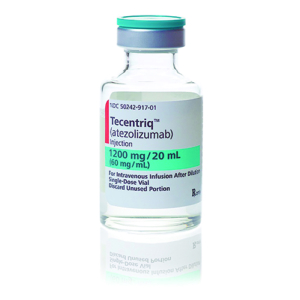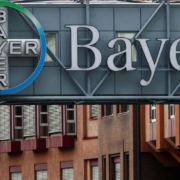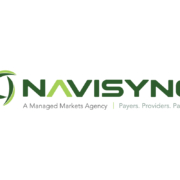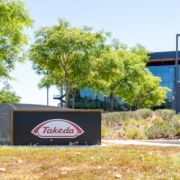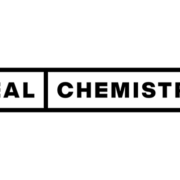Roche 2023: Committed to global impact, putting patients at its core
Moving forward, Roche is prioritizing and reimagining its R&D strategy to build a stronger portfolio.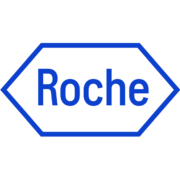
By Maria Fontanazza • [email protected]
Roche
Grenzacherstrasse 124, 4070 Basel, Switzerland
+41 61 688 11 11 • roche.com
| Financial Performance | ||||
| 2022 | 2021 | 1H 2023 | 1H 2022 | |
| Revenue | $66,263 | $65,760 | $31,182 | $33,817 |
| Net income | $14,169 | $15,639 | $7,919 | $9,593 |
| Diluted EPS | $16.09 | $16.96 | $9.29 | $11.04 |
| R&D Expense | $14,715 | $14,354 | $6,753 | $6,539 |
|
All figures are in millions of dollars, except EPS and were translated using the Federal Reserve Board’s average rate of exchange in 2022: SFr 0.9550. |
||||
Best-selling products
All sales are in millions of dollars and were translated using the Federal Reserve Board’s average rate of exchange in 2022: SFr 0.9550.
2022 sales
- Ocrevus $6,320
- Perjeta $4,280
- Hemlibra $4,003
- Tecentriq $3,892
- Actemra/RoActemra $2,828
- Xolair $2,312
- Herceptin $2,243
- Avastin $2,223
- Kadcyla $2,178
- Ronapreve $1,758
- MabThera/Rituxan $1,674
- Alecensa $1,584
- Activase/TNKase $1,232
- Evrysdi $1,172
- Lucentis $1,060 $
- Phesgo $775
- Gazyva/Gazyvaro $764
- Esbriet $752
- Vabysmo $619
- Pulmozyme $569
- CellCept $527
1H 2023 sales
- Ocrevus $3,351
- Hemlibra $2,185
- Perjeta $2,180
- Tecentriq $1,940
- Actemra/RoActemra $1,357
- Xolair $1,080
- Kadcyla $1,048
- Vabysmo $1,002
- Herceptin $882
- Avastin $876
- Alecensa $762
- Evrysdi $738
- MabThera/Rituxan $715
- Activase/TNKase $650
- Ronapreve $576
- Phesgo $541
- Gazyva/Gazyvaro $421
- Polivy $370
- Lucentis $313
Outcomes Creativity Index Score: 44
- Manny Awards — 2
- Cannes Lions — 2
- Clio Health — 8
- Creative Floor Awards — 18
- LIA: Pharma/Health & Wellness – 3
- MM+M Awards — 11
- One Show — N/A
Under new leadership and a new R&D strategy, Roche is poised to strengthen its base business and its commitment to deliver what it touts as the world’s most impactful medicines. Last year 14 million patients were treated with Roche medicines. By the end of 2022, Roche had 16 blockbuster drugs on the market (up from 7 in 2012). Based on FY 2022 sales, Evaluate and Bloomberg ranked the company number one in neurology and hemophilia A, and in vitro diagnostics; and number three in oncology. The company also ranked as the top pharma company by rare disease patient groups, according to Patient View, and the number one company in pharma in artificial intelligence readiness by CBInsight.
Thomas Schinecker, Ph.D. took the reins from Severin Schwan as CEO of Roche Group in March, and during the company’s 2023 Pharma Day, held in September, the company announced a strengthened R&D strategy, focused on “R&D Excellence.” The company currently ranks itself second in the number of pipeline assets in Phase I to Phase III studies as well as in new molecular entities with first-in-class potential amidst peers. However, according to Schinecker, Roche previously moved therapeutics to Phase III too quickly, resulting in a higher rate of Phase III failures more recently. The company decided to reallocate resources to research & development and has shifted its approach to R&D with a goal of driving efficacy and
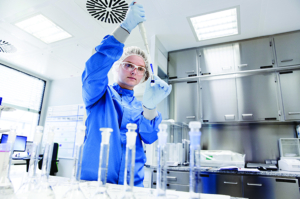
In September Roche announced a reinvigorated focus on its research & development capabilities, allocating additional resources to R&D and renewing its goal to drive efficacy and efficiency.
efficiency. The company also established a portfolio committee – consisting of Schinecker, Pharma CEO Teresa Graham, Head of pRED Hans Clevers, Head of gRED Aviv Regev, Head of Global Product Strategy Cristin Hubbard, Head of Product Development/CMO Levi Garraway, and Head of Partnering James Sabry – with the responsibility of taking a holistic view and managing R&D productivity end-to-end. Roche announced eight core operating principles moving forward: put patients first, follow the science, act as one team, embrace differences, accelerate learning, simplify radically, make impact now, and think long term.
In May, Roche launched the Institute of Human Biology (IHB) to focus on advancing research in human model systems (i.e., organoids) and reduce reliance on animal testing. Created from human stem cells, human model systems are miniature 2D or 3D living replicas of human tissues and organs. The goal is to not only enable the discovery of new disease and drug targets, but also better predict which drug candidates are safer and more effective. IHB brings together the biology, bioengineering, and data science around the human model systems and then applies them to the real-world hurdles in drug discovery and research. “Human model systems such as organoids are the future of our industry. They have the potential to enhance almost all the steps involved in the research and development of an innovative medicine,” says Professor Dr. Hans Clevers, head of pharma research and early development at Roche and a pioneer in the field of organoids. Roche expects the IHB will grow to about 250 scientists and bioengineers over the next four years.
The company also stated that it would be exiting its legacy Genentech manufacturing facility in Vacaville, California, as part of “a broader strategy to evolve its manufacturing capabilities in line with future pipeline requirements.”
Financial & product performance
Roche Group’s first half 2023 sales dropped 2 percent year-over-year at constant exchange rates (CER) to CHF (Swiss francs) 29.8 billion ($31.2 billion). Much of this decline can be attributed to the steep reduction in COVID-19-related tests, which led to a 23 percent fall in sales in the Diagnostics Division to CHF 7.1 billion ($7.4 billion). Sales in the Pharmaceutical Division were up 8 percent at CER to CHF 22.7 billion ($23.7 billion), thanks to the continuing acceptance of new medicines that also helped offset the negative affect of biosimilar competition to MabThera/Rituxan (rituximab), Herceptin (trastuzumab), and Avastin (bevacizumab), and driven by growing demand for Vabysmo (faricimab), Ocrevus (ocrelizumab), Hemlibra (emicizumab), Evrysdi (risdiplam), and Phesgo (pertuzumab/trastuzumab/hyaluronidase). These five drugs were responsible for CHF 2.2 billion (CER, $2.3 billion) in sales.
First-half 2023 core operating profit for Roche Group fell 6 percent CER to CHF 10.9 billion ($11.5 billion). IFRS net income decreased by 9 percent, and core earnings per share (EPS) decreased by 5 percent. Roche states that the appreciation of the Swiss franc against many currencies had an adverse net impact on the results expressed in Swiss francs compared to constant exchange rates. The Pharmaceuticals Division’s core operating profit increased by 5 percent at CER to CHF 11 billion ($11.5 billion), which was below the sales increase of 8 percent and partially attributed to the CHF 0.7 billion of income from the Ultomiris patent settlement in 2022. The Diagnostics Division core operating profit decreased by 36 percent at CER to CHF 1.6 billion ($1.7 billion).
Group IFRS net income for first-half 2023 decreased by 9 percent and core EPS by 5 percent at CER, both of which were driven by the core operating profit decline. Operating free cash flow was CHF 8.0 billion ($8.4 billion), declining 8 percent at CER or 18 percent in CHF as a result of lower operating results. Roche reported free cash flow at CHF 6.1 billion ($6.4 billion), a decrease of 2 percent at CER or 14 percent in CHF, due to the decline in the operating free cash flow and higher interest payments, partly offset by lower tax payments.
Highlighted first-half 2023 performance in Roche’s Pharmaceutical Division are as follows. Sales in oncology increased 4 percent at CER to CHF 9.8 billion ($10.2 billion), driven by Phesgo, Tecentriq (atezolizumab), Polivy (polatuzumab vedotin), and Perjeta (pertuzumab). The U.S. and European market continue to contribute to Phesgo’s growth, with the medicine experiencing a 69 percent increase in sales. Higher U.S. demand also helped Tecentriq grow by 12 percent, while Polivy sales increased across all regions (especially in Japan) 114 percent at CER. Despite its sales decline in Europe, Perjeta enjoyed 9 percent growth at CER in the United States and International regions, including Brazil and China.
First-half 2023 sales in immunology were down 13 percent year over year to CHF 3.1 billion ($3.2 billion). Contributors to the drop included lower demand from hospitalized COVID-19 patients, which caused Actemra/RoActemra (tocilizumab) to fall by 6 percent (CER); generic competition, which drove down Esbriet (pirfenidone) sales by 73 percent (CER). Roche Group expects the first biosimilar versions of Actemra/RoActemra to hit the U.S. and EU market in the second half of 2023. Xolair was up 4 percent (CER) due to its growth in the chronic spontaneous urticaria indication. Best-seller Ocrevus, along with Evrysdi, aided Roche’s neuroscience business, with the segment growing 18 percent (CER) to reach CHF 4.2 billion ($4.4 billion). Infectious diseases grew 14 percent (CER) to CHF 819 million ($858 million). Ophthalmology sales hit CHF 1.27 billion ($1.3 billion), growing 89 percent (CER), which is notable growth considering the fact that Lucentis (ranibizumab) sales dropped 46 percent (CER). The first biosimilar version of Lucentis with a restricted label came to market in the United States at the beginning of Q3 2022. Interim U.S. sales of Lucentis were CHF 299 million ($313 million). In other therapeutic areas, sales grew 5 percent (CER), helped by the 15 percent at CER growth of Activase/TNKase (tenecteplase).
R&D costs increased 9 percent to CHF 5.6 billion ($5.9 billion), with oncology being the main area of focus, followed by neuroscience, immunology, ophthalmology, and computational biology. Roche’s investments in new facilities also added to the additional cost growth.
As previously mentioned, Roche’s Diagnostics Division felt the effects of far less demand for COVID-19-related tests. Yet, first-half 2023 base business grew by 6 percent at CER and across all regions, with immunodiagnostics (boosted by cardiac tests) driving key growth. R&D costs increased by 2 percent, with investments in sequencing and in infectious diseases serving as growth drivers. The company expects that Diagnostics will deliver mid-to-high single-digit growth in the coming years, with its base business continuing its strong momentum and COVID sales to be “washed out” by Q1 2024.
Product & pipeline updates
More than a dozen of Roche’s products ranked on the Med Ad News Top 200 Prescription Medicines by 2022 Global Sales (see August 2023 issue of Med Ad News): Ocrevus, Perjeta, Hemlibra, Tecentriq, Xolair (omalizumab), Lucentis, Actemra/RoActemra, Herceptin, Avastin, Kadcyla (trastuzumab emtansine), Rituxan/MabThera, Venclexta/Venclyxto (venetoclax), Alecensa (alectinib), Activase (alteplase) and TNKase (tenecteplase), and Evrysdi.
In September Roche announced positive Phase III results for its ALINA study evaluating non-small cell lung cancer (NSCLC) treatment Alecensa versus chemotherapy. The study met its primary endpoint of disease-free survival. Alecensa demonstrated a statistically significant and clinically meaningful improvement in DFS as adjuvant therapy in people with completely resected stage IB (tumor ≥4cm) to IIIA (UICC/AJCC 7th edition) anaplastic lymphoma kinase (ALK)-positive NSCLC. Alecensa is the first and only ALK inhibitor to demonstrate a reduction in the risk of disease recurrence or death for people with early-stage ALK-positive NSCLC in a Phase III trial. “Alecensa has transformed outcomes for people with advanced ALK-positive NSCLC, and now these strong results provide evidence for the first time that this medicine could also play a pivotal role in early-stage disease where there is significant unmet need,” said Levi Garraway, M.D., Ph.D., Roche’s chief medical officer and head of global product development. “If approved, Alecensa has the potential to treat cancer before it has spread in a setting where treatment can increase the chances of cure, which is our ultimate goal at Roche. We look forward to sharing these data with regulatory authorities in hopes of bringing this to patients as quickly as possible.”
At the end of August Tecentriq SC was approved by the UK’s Medicines and Healthcare products Regulatory Agency (MHRA). The drug, which is Roche’s fourth subcutaneous cancer therapy, became the first subcutaneous anti-PD-(L)1 cancer immunotherapy to be made available in Great Britain with an administration time under the skin of about 7 minutes (versus 30-60 minutes intravenous infusion). Tecentriq SC is being made available to patients in Great Britain for all indications in which the IV formulation of Tecentriq has been previously approved, including certain types of lung, bladder, breast, and liver cancer. “Cancer immunotherapy has transformed the way we treat cancer. Giving Tecentriq subcutaneously now offers patients a faster and more flexible treatment option and can free up resources for healthcare systems, while maintaining its established safety profile,” said Garraway. “We are working with health authorities globally to bring this option to many more patients around the world.” The MHRA regulatory approval is the first for Tecentriq SC worldwide.
Earlier in the year Roche released positive data from a Phase III study that examined the use of Tecentriq plus Avastin in the adjuvant hepatocellular carcinoma (HCC) setting, showing that the combination reduced the risk of disease recurrence by 28 percent (compared with active surveillance). The IMbrave050 study data also indicated that the investigational combination of Tecentriq plus Avastin is the first treatment in more than a decade to significantly improve overall survival over the existing standard of care, Roche stated.
In August the European Commission approved the extension of the marketing authorization of Evrysdi to include infants with a clinical diagnosis of spinal muscular atrophy (SMA) Type 1, Type 2, or Type 3 or with one to four SMN2 copies from birth to below two months. Although Evrysdi is available to treat people of all ages with SMA in the EU, the labeling extension helps enable the treatment of babies soon after birth with the drug, which gives them “the greatest chance to achieve the milestones of sitting, standing, and walking, similar to healthy children,” said Garraway. The European Commission approval is based on the RAINBOWFISH interim analysis, which included six babies with two or three copies of the SMN2 gene who completed at least one year of study assessments. The RAINBOWFISH data show that the safety profile of Evrysdi in pre-symptomatic babies is consistent with the safety profile seen in previous trials with symptomatic SMA patients. Evrysdi was initially approved in Europe in March 2021 for treating patients two months or older. Roche is currently investigating Evrysdi in combination with an anti-myostatin molecule targeting muscle growth in the Phase II/III trial MANATEE for the treatment of SMA.

In addition to its treatment for nAMD and DME, Vabysmo is being looked at for macular edema following retinal vein occlusion. FDA accepted Roche’s supplemental Biologics License Application for this indication earlier in the year.
With more than one million doses distributed globally, ophthalmic treatment Vabysmo was a major growth driver in the first half of 2023. In July Roche announced data that supports the use of Vabysmo as a treatment of neovascular or “wet” age-related macular degeneration (nAMD) and diabetic macular edema (DME), which are leading causes of vision loss globally. Affecting more than 20 people worldwide, “wet” AMD is an advanced form of AMD, occurring when new and abnormal blood vessels grow uncontrolled under the macula, leading to swelling, bleeding, and/or fibrosis. Affecting more than 21 million people worldwide, DME is a retinal condition that occurs when damaged blood vessels leak into and cause swelling in the macula; the number of people with DME is expected to continue to grow with the increased incidence of diabetes. Vabysmo is approved in more than 70 countries to treat nAMD and DME, and has public reimbursement in more than 20 markets. Roche presented 25 abstracts at the 2023 American Society of Retina Specialists (ASRS) Annual Meeting. Highlights included late-breaking post-hoc data suggest that Vabysmo leads to less fibrosis, which may negatively impact vision, than aflibercept in DME patients; and real-world data that supports Vabysmo’s first-line use to improve outcomes and rapidly extend the first four month’s treatment intervals in for people with DME and nAMD. Clinical data also showed positive anatomical outcomes for the drug, including a reduction in blood vessel leakage in the macula, and greater and faster control of retinal fluid. There are more than 8,500 participants in nearly 30 countries involved in Roche’s studies for Vabysmo. In May the FDA accepted Roche’s supplemental Biologics License Application for Vabysmo in treating macular edema following retinal vein occlusion.
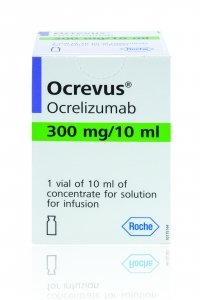
When used in combination with Halozyme Therapeutics’ Enhanze drug delivery technology, multiple sclerosis treatment Ocrevus achieved positive results as a twice-a-year 10-minute subcutaneous injection.
Roche announced positive results for its multiple sclerosis treatment Ocrevus, which was being assessed as a twice-a-year 10-minute subcutaneous injection. This investigation subcutaneous formulation combines Ocrevus with Halozyme Therapeutics’ Enhanze drug delivery technology, which is based on a proprietary recombinant human hyaluronidase PH20, an enzyme that locally and temporarily degrades hyaluronan, thus increasing permeability of the tissue under the skin and allowing more rapid absorption into the bloodstream. In the Phase III OCARINA II trial, Ocrevus met is primary and secondary endpoints in patients with relapsing forms of MS or primary progressive MS (RMS or PPMS). The subcutaneous injection was shown to be non-inferior to Ocrevus given by intravenous infusion (IV), as measured by pharmacokinetics over 12 weeks. The Ocrevus subcutaneous injection was also comparable with the Ocrevus IV in controlling MRI lesion activity in the brain over 12 weeks. In addition, the safety profile of Ocrevus subcutaneous injection was consistent with that of the Ocrevus IV. When administered as a 10-minute injection, Ocrevus is intended to be used without the need for IV infrastructure, which could greatly expand the drug’s use. “These results give people living with MS the possibility to receive the transformational benefits of Ocrevus in the way best suited to their lives while freeing up time and healthcare resources,” said Garraway. “This new subcutaneous injection will allow Ocrevus to be administered in 10 minutes twice a year, helping people living with MS to spend less time in treatment for this disease.’’
In July Roche entered into a partnership with Alnylam to jointly develop and commercialize Phase II investigational RNAi therapeutic zilebesiran for hypertension patients who have high cardiovascular risk. Positive Phase I data showed that zilebesiran compared to placebo, was associated with dose-dependent reductions in serum angiotensinogen (AGT), achieving tonic blood pressure control with consistent and durable blood pressure reduction throughout 24 hours, sustained up to six months after single doses of ≥200 mg. It also showed an acceptable safety profile for continued clinical development.
“We are excited to work together with Alnylam and leverage our strong R&D capabilities, our leadership in cardiovascular diagnostics and our global commercial footprint to further develop and provide this promising therapy with best-in-disease potential to patients,” said Teresa Graham, CEO of Roche Pharma. “Throughout our history, we have redefined the standard of care across various disease areas. Together with a strong partner like Alnylam, we are looking forward to making a significant impact for patients living with hypertension at high cardiovascular risk and potentially other cardiovascular indications.”
Alnylam’s KARDIA Phase II program is looking at zilebesiran’s safety and efficacy as either a monotherapy (KARDIA-1) or in combination with one of three standard-of-care antihypertensive medications (KARDIA-2). In September Roche and Alnylam announced that the Phase II study KARDIA-1 of zilebesiran met the primary endpoint, showing significant reduction in 24-hour mean systolic blood pressure at month three, achieving a placebo-subtracted reduction greater than 15 mmHg with both 300- and 600-mg doses. “These early results indicate the potential for zilebesiran to achieve sustained blood pressure reduction with quarterly or biannual dosing,” said Garraway. “Also, these data underscore the potential of this investigational medicine to provide transformative impact for many people living with uncontrolled hypertension.’’
Another win for Roche was the U.S. and EU approvals of Columvi (glofitamab) for treating the most common and aggressive form of blood cancer, relapsed or refractory (R/R) diffuse large B-cell lymphoma (DLBCL). Columvi is part of Roche’s portfolio of T-cell engaging bispecific antibodies in non-Hodgkin lymphoma.
In June FDA granted accelerated approval based on the response rate and durability of response in the Phase I/II NP30179 study, which involved giving patients Columvi as a fixed course for 8.5 months in 132 patients with DLBCL who had relapsed or were refractory to prior therapies, including about one-third (30 percent) who had received prior CAR T-cell therapy. Positive results showed that patients treated with fixed-duration Columvi achieved durable remission, with 56 percent of patients achieving an overall response and 43 percent of patients achieving a complete response. In addition, more than two-thirds of those who responded continued to respond for at least nine months. “Patients with relapsed or refractory diffuse large B-cell lymphoma may experience rapid progression of their cancer and often urgently need an effective treatment option that can be administered without delay,” said Krish Patel, M.D., director of the Lymphoma Program at the Swedish Cancer Institute in Seattle and investigator of the Columvi Phase I/II NP30179 study. “Experience from clinical trials demonstrates that Columvi can provide patients with relapsed or refractory diffuse large B-cell lymphoma a chance for complete remission with a fixed duration immunotherapy and that such remissions can potentially be sustained after the end of their treatment.”
Conditional marketing authorization, granted by the European Commission in July, was also based on results from the Phase I/II NP30179 study. Roche continues to expand the clinical development program for Columvi, which includes evaluating its use in combination with gemcitabine and oxaliplatin (GemOx) versus rituximab in combination with GemOx in patients with second-line plus DLBCL who are ineligible for autologous stem cell transplant. The company also has more Phase III studies in the works, including in first-line DLBCL.
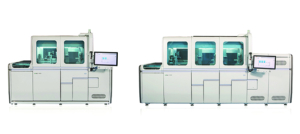
In June the World Health Organization awarded prequalification to the cobas HPV test for use on the cobas 6800/8800 Systems, greatly expanding screening for the human papillomavirus.
In February Roche announced the launch of two new antibodies to its neuropathology portfolio, IDH1 R132H (MRQ-67) Rabbit Monoclonal Primary Antibody and the ATRX Rabbit Polyclonal Antibody, to identify mutation status in patients diagnosed with brain cancer. Gliomas, or brain tumors, that have mutations in the IDH1 and ATRX genes are biologically distinct from tumors that do not carry these mutations, and thus knowing whether a patient has IDH1 and ATRX mutations helps clinicians provide a more informed prognosis and more personalized care, including whether the patient is eligible for clinical trials.
In June Roche was awarded the World Health Organization (WHO) prequalification for its cobas HPV test, enabling improved access to cervical cancer screening in low- and lower-middle income countries (LMICs). The WHO estimates that each year, more than 600,000 women are diagnosed with cervical cancer worldwide, with more than 340,000 dying from the disease, which is caused by infection with the human papillomavirus (HPV). An estimated nine out of ten women who die from cervical cancer live in LMICs. “The elimination of cervical cancer is within reach. Roche is committed to working with governments, non-profit organizations and funders to help build sustainable cervical cancer elimination programs so that women, no matter where in the world they live, no longer die from this preventable disease,” said Roche Diagnostics CEO Matt Sause.
Collaborations & partnerships
In March Roche and Eli Lilly announced a collaboration involving the development of Roche’s Elecsys Amyloid Plasma Panel (EAPP), a blood test that intends to diagnose Alzheimer’s disease earlier. The EAPP measures phosphorylated Tau (pTau) 181 protein assay and apolipoprotein (APOE) E4 assay in human blood plasma. Elevated pTau 181 can indicate early stages of Alzheimer’s disease; the presence of APOE4 indicates the most common genetic risk factor of the disease. The result of the panel is supposed to be used with additional clinical information to guide further confirmatory testing with amyloid positron emission tomography or cerebrospinal fluid testing. “Today, over 55 million people are living with dementia, and this is projected to increase to nearly 140 million by 2050,” Sause said. “Collaboration is essential to ensure these people receive a timely and accurate diagnosis. The Elecsys Amyloid Plasma Panel has the potential to streamline a person’s journey to diagnosis and, therefore, access to future treatment options.” The EAPP is not yet approved, but it has demonstrated clinical performance and is undergoing investigation to ensure clinical validation.
At the end of 2022, Roche and Pfizer collaborated on an educational COVID-19 campaign to drive awareness about the importance of timely testing, as well as the symptoms, high-risk factors, and treatment options available.



